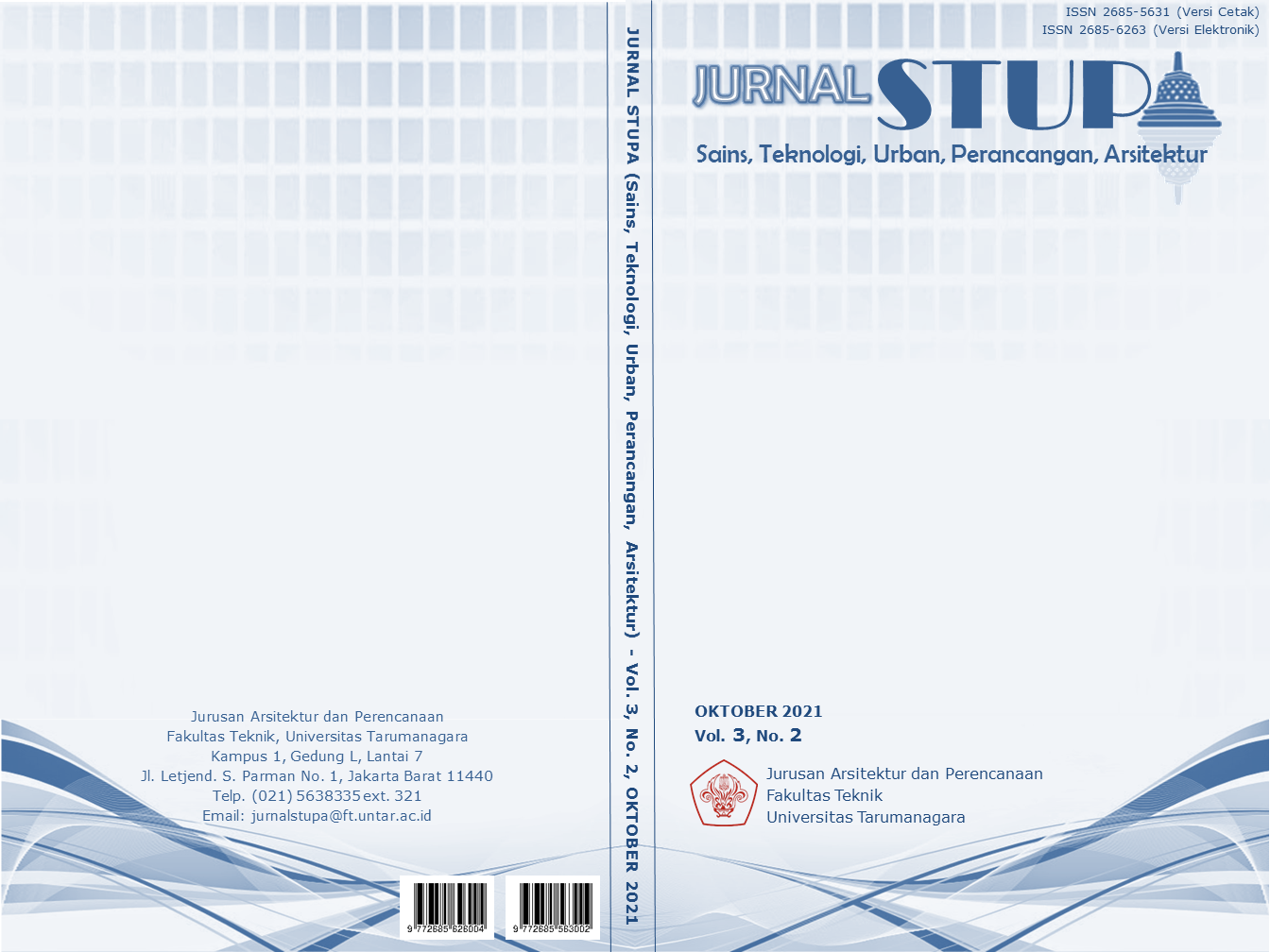HABITAT KEANEKARAGAMAN HAYATI DAN PUSAT JAJANAN SEBAGAI PEMBANGKIT LISTRIK TENAGA BIOENERGI
Isi Artikel Utama
Abstrak
The Covid-19 phenomenon makes humans stimulates their relationship with ecosystems, thereby accelerating ecological awareness, that there are other entities must be considered besides humans. Anthropocentrism is the understanding that humans are the most powerful species than other creatures, the discussed one anthropocentrism activity are about the massive development of business areas in the middle of Jakarta. The purpose of this project is to evaluate massive development by adding development policies that pay attention to spaces for creatures other than humans, namely animals and plants. This kind of thinking is called ecosophy, which means wise in ecological living. Hypothetically, the green open space applied to the design can be used as a habitat for living things and can also be used as a power plant using biogas and biocathode processes. Biogas is natural gas that is processed anaerobically or without oxygen, the raw material comes from food scraps contained in the food court program in the form of organic material substrates. Biocathode is the process of absorbing electrons that produced by microbes from photosynthesis process that uses electrodes to absorb electrons. Both processes produce energy that comes from nature or known as bioenergy, which is used to generate electricity on an environmental scale. Therefore, the project focuses on design that is not only sustainable but also regenerating the surrounding environment. The results about the project are to present a building with an ecosophy thinking that puts forward ecological policies in designing, it has a mutualistic relationship in the form of a biodiversity habitat that supplies organic material substrates to be used by humans to obtain electricity generated from bioenergy.
Keywords: anthropocentricism; bioenergy; biogas; biocathode; ecosophy.
Abstrak
Fenomena Covid-19 membuat manusia merefleksikan kembali hubungannya dengan ekosistem sehingga mempercepat kesadaran ekologis, bahwa ada entitas lain yang harus diperhatikan selain manusia. Antroposentrisme adalah paham bahwa manusia adalah spesies paling berkuasa daripada makhluk lainnya, kegiatan antroposentrisme yang di angkat adalah pembangunan masif kawasan-kawasan bisnis ditengah kota Jakarta. Tujuan proyek ini bertujuan mengevaluasi pembangunan masif dengan menambahkan kebijakan pembangunan yang memperhatikan ruang untuk makhluk selain manusia yaitu hewan dan tumbuhan. Pemikiran seperti ini disebut dengan ecosophy, yang berarti bijak dalam kehidupan ekologis. Secara hipotesa ruang terbuka hijau yang diterapkan pada perancangan dapat dimanfaatkan sebagai habitat makhluk hidup dan dapat dimanfaatkan juga sebagai pembangkit listrik menggunakan proses biogas dan biokatoda. Biogas adalah gas alam yang terproses secara anaerobik atau tanpa oksigen, bahan bakunya berasal dari sisa makanan yang terdapat pada program pusat jajanan dalam bentuk substrat bahan organik. Biokatoda adalah proses penyerapan elektron yang dihasilkan mikroba dari hasil fotosintesis yang menggunakan alat elektroda untuk menyerap elektron. Kedua proses tersebut menghasilan energi yang berasal dari alam atau disebut dengan bioenergi, yang digunakan sebagai pembangkit listrik untuk skala lingkungan. Dengan cara ini didapatkan bahwa proyek ini berfokus kepada perancangan yang bukan hanya berkelanjutan tetapi juga memperbarui lingkungan sekitarnya. Hasil yang di dapat pada proyek ini adalah menghadirkan sebuah bangunan dengan pemahaman ecosophy yang mengedepankan kebijakan ekologis dalam merancang, mempunyai hubungan mutualisme dalam bentuk habitat keanekaragaman hayati yang menyuplai substrat bahan organik untuk dapat dimanfaatkan oleh manusia mendapatkan listrik yang dihasilkan dari bioenergi.
Rincian Artikel
Referensi
Alaimo, S. (2010). Bodily Natures: Science, Environtment, and The Material Self. Bloomington, Indiana: Indiana University Press.
Bar, H. (2020). COVID-19 Lockdown: Animal Life, Ecosystem and Atmospheric Environtment. Springer Nature.
Bilqis, N. (2020). Analisis Dampak Kasus Kebakaran Hutan di Indonesia Terhadap Hubungan Diplomatik Indonesia dengan Malaysia dan Singapura. Gorontalo Journal of Goverment and Political Studies.
Bratton, B. H. (2015). The Stack: On Software and Sovereignity. Massachusetts: The MIT Press.
Broadbent, S., & Lobet-Maris, C. (2015). Towards a Grey Ecology. Dalam L. Floridi, The Online Manifesto: Being Human in a Hyperconnected Era (hal. 111-124). New York City: Springer Publishing.
Cohen, J. J. (2013). Prismatic Ecology: Ecotheory Beyond Green. Minneapolis: University of Minnesota Press.
Cook, C. (2019). Regenerative Architecture as a pathway beyond sustainability . Diambil kembali dari issuu.com: https://issuu.com/catherineronniecook/docs/regenerative_architecture_as_a_pathway_beyond_sust
Devall, B. (1985). Deep Ecology. Layton, Utah: Gibbs M. Smith, Inc.
Fachverband Biogas e.V. (2019). Biowaste to Biogas. Angerbrunnenstraße: Fachverband Biogas e.V.
Gowtham, R., & Sundar, K. (2015). Generating Current From Plants Plant-e Technology.
Haenlein, A. F. (2016). The emergence and evolution of trans-corporeality in Charles Darwin's On The Origin of Species and. Graduate Theses and Dissertations. 15027.
Mazzoleni, I. (2013). Architecture Follows Nature: Biomimetic Principles for Innovative Design. CRC Press.
McDonough, W., & Braungart, M. (2002). Cradle to Cradle: Remaking The Way We Make Things. New York: North Point Press.
Naboni, E., & Havinga, L. (2019). Regenerative Design in Digital Practice: A Handbook for the Built Environtment. Bolzano: IT:Eurac.
Walter V, R., Mariam K, A., & Christopher B, F. (2020, January). The Future of Bioenergy. Glob Chang Biol, 274-286. doi:10.1111/gcb.14883
Young, L. (2019). Neo-Machine: Architecture Without People. Dalam L. Young, Machine Landscapes: Architectures of The Post-Anthropocene (hal. 6-10). Oxford: John Wiley & Sons Ltd.


